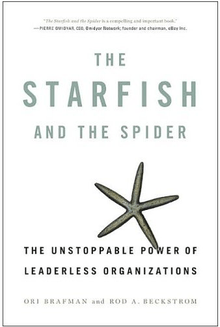The Starfish and the Spider

The Starfish and the Spider: The Unstoppable Power of Leaderless Organizations is a 2006 book by Ori Brafman (author of the 2010 book "Click: The Magic of Instant Connections" ISBN 978-0-385-52905-1) and Rod Beckstrom is an exploration of the implications of the recent rise of decentralized organizations such as Wikipedia, Grokster and YouTube. The book contrasts them to centralized organizations, such as Encyclopædia Britannica, using compendia of knowledge as examples. The spider and starfish analogy refers to the contrasting biological nature of the respective organisms, starfish having a decentralized neural structure permitting regeneration.
In addition to giving historical examples of decentralized organizations such as Alcoholics Anonymous and the Apaches and analyzing their nature in contrast to centralized organizations, the book considers conflict between centralized and decentralized organizations, including the "If you can't beat them, join them" solution of creating hybrid organizations such as Citizendium. A chapter towards the end of the book explores the concept of the "sweet spot", the optimal mix of decentralized and centralized attributes.
Catalysts
The book identifies a set of people the authors call "catalysts", who tend to be skilled at creating decentralized organizations. The authors list several abilities and behaviors (called "The Catalyst's Tools") that "catalysts" have in common, including:
- Genuine interest in others.
- Numerous loose connections, rather than a small number of close connections.
- Skill at social mapping.
- Desire to help everyone they meet.
- The ability to help people help themselves by listening and understanding, rather than giving advice ("Meet people where they are").
- Emotional Intelligence.
- Trust in others and in the decentralized network.
- Inspiration (to others).
- Tolerance for ambiguity.
- A hands-off approach. Catalysts do not interfere with, or try to control the behavior of the contributing members of the decentralized organization.
- Ability to let go. After building up a decentralized organization, catalysts move on, rather than trying to take control.
This book has some similarities to books like The Tipping Point, by Malcolm Gladwell, as both identify certain sets of people who are important to change in a society or an organization, and try to define the attributes that people belonging to these sets have in common. The theoretical base draws richly from complexity writers in management, such as Ralph Stacey, Margaret Wheatley, Dee Hock, Doug Griffin, Patricia Shaw, John Holland, and Robert Axelrod, among others. The book provides an original and accessible way to see these principles in action.
"A leader is best when people barely know that he exists; not so good when people obey and acclaim him; worst when they despise him." (p115) (Lao-tzu)
"As a catalyst, it's all about letting go and trusting the community." (p111)
Catalyst Examples
The book talks about 'catalysts', the people who found a starfish group and who gives it form, ideas, value, focus, and meaning. Some examples of such human catalysts in the book include:
- Granville Sharp, leader of the abolitionist movement against slavery in England
- Elizabeth Cady Stanton, who founded the women's suffrage movement that Susan B. Anthony later took up with still greater energy
- Craig Newmark of craigslist
- Bill Wilson of Alcoholics Anonymous
- Jimmy Wales of Wikipedia
The Ten Rules
The ten "rules" are:
- Diseconomies of scale- Small companies have power.
- Network effect - every additional person makes the organization stronger.
- Power of chaos.
- Knowledge at the edge - information about the organization is open to everybody.
- Everyone wants to contribute - self-motivated employees.
- Beware the hydra response.
- Catalysts rule.
- *Values* are the heart of any organization or network.
- Measure, monitor, and manage.
- Flatten or be flattened.
Five Legs
The five legs to a starfish organization:
- Circles
- The Catalyst
- Ideology
- The Pre-existing Networks
- The Champion
The Major Principles of Decentralization
- When attacked, a decentralized organization tends to become even more open and decentralized (p21)
- It's easy to mistake starfish for spiders (p36)
- An open system doesn't have central intelligence; the intelligence is spread throughout the system (p39)
- Open systems can easily mutate (p40)
- The decentralized organization sneaks up on you (p41)
- As industries become decentralized, overall profits decrease (p45)
- Put people into an open system and they’ll automatically want to contribute (p74)
- When attacked, centralized organizations tend to become even more centralized (p139)
See also
External links
Further reading
- The Starfish And the Spider: The Unstoppable Power of Leaderless Organizations, Penguin (October 5, 2006), hardcover, 230 pages, ISBN 1-59184-143-7
References
- Originally adapted from the Wikinfo article The Starfish and the Spider